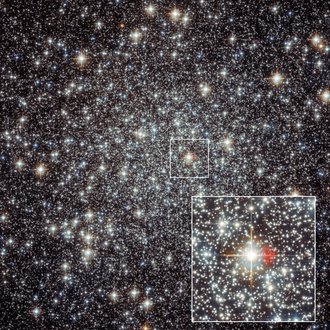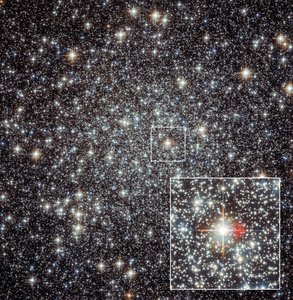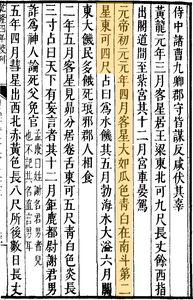Nova rediscovered after more than 2,000 years

Illustration of the Nova’s position in the globular cluster M22.
Credit: ESA/Hubble und NASA; Montage: F. GöttgensModern astronomical observations now discovered the remnant of a nova explosion whose position corresponds to a celestial phenomenon described in ancient Chinese records. The discovery thus confirms one of the oldest astronomical observations outside the solar system.
A European team of astronomers, including researchers from the Leibniz Institute for Astrophysics Potsdam (AIP), detected the remnant of an old nova in the globular cluster Messier 22 with the MUSE instrument at the Very Large Telescope operated by ESO in Chile. According to records in the Chinese chronicle Book of Han, a "guest star" was seen in the same region of the sky in 48 BC, i.e. a previously invisible or new (nova) star that disappeared from the sky after a while.
"The position and brightness of the remnant match the entry from 48 BC" says Fabian Göttgens of the Institute for Astrophysics at the University of Göttingen and first author of the now published study. Prof. Dr. Martin Roth, scientist at AIP, explains why this confirmation of an old measurement is possible thousands of years later: "Astronomical phenomena often extend over very long periods of time – sometimes modern measurements can be supported by historical observations." Novae and supernovae were known to Chinese, Arab, Greek and Babylonian astronomers thousands of years ago. The oldest Chinese astronomical records are a remarkable 3,400 years old. "With modern and sensitive instruments, and some luck, even less severe stellar eruptions are detectable after more than 2,000 years," adds Dr. Peter Weilbacher of AIP.
The globular cluster M22 is one of about 150 globular clusters orbiting our Milky Way. It is located in the constellation Sagittarius in the direction of the center of the Milky Way and consists of several hundred thousand very old stars and binary star systems. Novae are eruptions on the surface of a white dwarf star in a binary system. The released energy increases the luminosity by several orders of magnitude, so that they can be observed for a short time as a "star" from Earth. The ejected material distributes itself at high speed and forms a luminous nebula, which thins out more and more over time.
The MUSE instrument, a 3D spectrograph, was built with the participation of AIP. MUSE splits starlight into its colors and measures the brightness of stars as a function of color. This makes it particularly suitable for finding nebulae that often glow in a certain color. The now discovered remnant of the nova forms a red shining nebula of hydrogen and other gases, which has a diameter of about 8,000 times the distance between Earth and the Sun. Despite its size, the nebula is relatively light. The new measurements estimate its mass at about 30 Earth masses.
High technology, such as that of MUSE, thus creates a link between modern astronomy and the meticulously documented observations of Chinese astronomers more than 2,000 years ago.
Further information
University of Göttingen press release
https://www.uni-goettingen.de/en/73613.html?id=5421
More about Muse
https://www.aip.de/en/research/projects/muse/
Publication
Fabian Göttgens, Peter M. Weilbacher, Martin M. Roth, Stefan Dreizler, Benjamin Giesers, Tim-Oliver Husser, Sebastian Kamann, Jarle Brinchmann, Wolfram Kollatschny, Ana Monreal-Ibero, Kasper B. Schmidt, Martin Wendt, Lutz Wisotzki, and Roland Bacon, "Discovery of an old nova remnant in the Galactic globular cluster M 22," Astronomy & Astrophysics (2019).
Images
Illustration of the Nova’s position in the globular cluster M22.
Chinese inscription describing the nova in 48 BC (in yellow).




